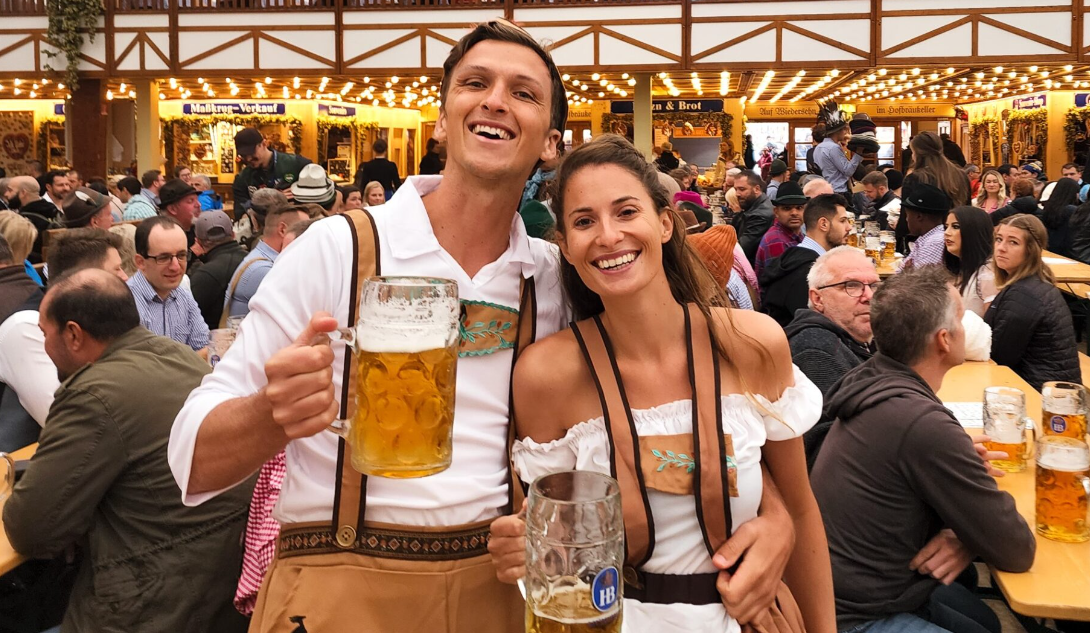As the vibrant hues of autumn begin to paint the landscape, there’s a palpable sense of excitement that sweeps across Bavaria and beyond. It’s that time of the year when Munich’s Theresienwiese bursts into a kaleidoscope of colors, laughter, and celebration. The lively strains of traditional Bavarian music mingle with the tantalizing aroma of sausages and pretzels, while the clinking of beer steins punctuates the air. It’s Oktoberfest, the world’s largest beer festival, and at its heart lies a cherished symbol of Bavarian culture: the Dirndloutfit .
Unveiling the Dirndl: A Dive into Tradition
From the Alpine Meadows to the Festive Grounds
The Dirndl, a traditional Bavarian dress, exudes an air of timelessness that is both captivating and steeped in history. Its roots trace back to the 19th century, when it was embraced as everyday attire by the Alpine dwellers of southern Germany, Austria, and Switzerland. Originally worn by peasants, the German Dirndl encapsulated practicality with its layered design, featuring a bodice, blouse, full skirt, and apron.
As the years progressed, the Dirndl outfit seamlessly melded into the realm of celebrations, especially during Oktoberfest. This festival, inaugurated in 1810 to commemorate the Bavarian Crown Prince Ludwig’s marriage to Princess Therese, is the ideal stage for the Dirndl to shine. Today, it’s fascinating to see how this attire has transcended social strata and become a unifying emblem of Bavarian pride.
The Dirndls Anatomy: A Symphony of Elegance
Decoding the Elements
The Dirndls design is a harmonious blend of elements, each with its own tale to tell. Let’s embark on a journey through its intricate anatomy:
Bodice: The bodice is the heart of the German Dirndl, offering a snug and flattering fit. Crafted meticulously, it showcases delicate embroidery, elaborate buttons, and even intricate lacework, all contributing to its exquisite charm.
Blouse: Peeking from beneath the bodice is the blouse, often featuring puffed sleeves and delicate necklines. It adds a touch of modesty and softness to the ensemble.
Skirt: The voluminous skirt sways with every step, creating a graceful silhouette. A canvas for creativity, it’s adorned with vibrant patterns and fabrics, allowing wearers to express their personality.
Fast forward to the present, and Dirndl has achieved global recognition. Designers have embraced its potential, experimenting with fabrics, cuts, and colors, yet always paying homage to its heritage. Today, you’ll find variations that suit diverse tastes, from classic and elegant to modern and avant-garde.
Steeped in Symbolism: Unveiling the Cultural Significance
More Than Just Fabric
Beyond its aesthetic allure, the Dirndl is laden with cultural significance. It embodies a sense of belonging, reflecting the values and traditions of Bavaria. Each element of the Dirndl outfit conveys a story—of love, heritage, and community. The apron’s placement, the choice of fabric, and the accessories worn alongside it all contribute to a visual narrative that has been handed down through generations.
Pro Tips for Rocking Your Dirndl: A Style Guide
Embracing the Essence
| Perfect Fit | The right fit is paramount. A well-fitted Dirndl enhances your silhouette and exudes confidence. |
| Layering Magic | Pay attention to layering—the blouse, bodice, skirt, and apron should seamlessly complement each other. |
| Accessorize Thoughtfully | Choose accessories that enhance the ensemble without overwhelming it. Delicate necklaces, earrings, and a charming handbag can be the perfect finishing touch. |
Embracing Tradition: Personal Experiences and Anecdotes
Stories That Breathe Life into Fabric
Every Dirndl carries with it a story, often whispered through family tales or captured in old photographs. For many Bavarians, the Dirndl is more than just an outfit—it’s a link to their ancestors, a reminder of festive gatherings, and a testament to the enduring spirit of their culture.
Growing up, I vividly recall my grandmother’s eyes lighting up as she recounted stories of her own Dirndl-clad adventures. She spoke of swirling skirts, lively dances, and shared laughter. These narratives painted a picture of a time when the German Dirndl wasn’t just worn—it was lived in, experienced, and cherished.
A Timeline of Transformation: Evolution of the Dirndl
From Rural Roots to Runways
The Dirndls journey has been one of evolution, influenced by changing fashion trends while retaining its essence. In the early 20th century, it evolved to cater to urban sensibilities, becoming more streamlined and refined. However, its rustic charm was never lost, and it continued to be cherished as a link to tradition.
In Conclusion: Celebrating Heritage Through Fabric and Thread
As the melodies of the Oktoberfest fade into the distance and the Dirndls are carefully stored away, their legacy endures. The Dirndls journey from humble beginnings to the glitzy runways is a tale of transformation, resilience, and cultural pride. It’s a piece of living history that continues to weave its magic, reminding us of the beauty in tradition, the elegance in simplicity, and the stories that garments can tell.
So, as you slip into your Dirndl outfit, take a moment to appreciate the craftsmanship, the heritage, and the generations that have embraced this attire. Let the threads of history wrap around you, and as you twirl in its folds, remember that you’re not just wearing a dress—you’re wearing a piece of Bavaria’s heart and soul.
Read article more lifeexmedia

